Abstract
1. Adenosine-5'-triphosphate (ATP) is known to exert a variety of biological effects via the activation of either ionotropic P2x- or G-protein coupled P2Y-purinoceptor subtypes. In this study the effects induced by ATP and ATP analogues on rat bladder strips were characterized at resting tone and in carbachol-prestimulated tissues. 2. ATP exerted a clear concentration-dependent biphasic response, which was maximal at 1 mM concentration and was characterized by an immediate and transient contraction, followed by a slower sustained relaxation. The receptor mediating contraction was susceptible to desensitization by ATP and by the ATP analogue, alpha,beta-methyleneATP (alpha,beta-meATP) showing the typical features of the P2x-purinoceptor; conversely, ATP-evoked relaxation did not undergo tachyphylaxis following either ATP or alpha,beta-meATP. 3. The slower and sustained relaxant phase seemed to be due to activation of P2Y-purinoceptors, based on responses obtained with the P2Y agonist, 2-methyl-thioATP (2-meSATP) and, more importantly, based on the clear involvement of the G-proteins. In fact, the G-protein activator, guanosine 5'-O-(3-thiotriphosphate) (GTP gamma S) significantly potentiated and the G-protein blocking agent, guanosine 5'-O-(2-thio-diphosphate) (GDP beta S) completely abolished the ATP-induced relaxation. No effects were exerted by these two G-protein modulators on the ATP-induced contraction. 4. The relaxant component of the ATP response of bladder tissue was not significantly influenced by nitro-benzyl-thioinosine (NBTI) or by 8-phenyltheophylline (8-PT), suggesting that the contribution of the ATP metabolite adenosine to this response was negligible.(ABSTRACT TRUNCATED AT 250 WORDS)
Full text
PDF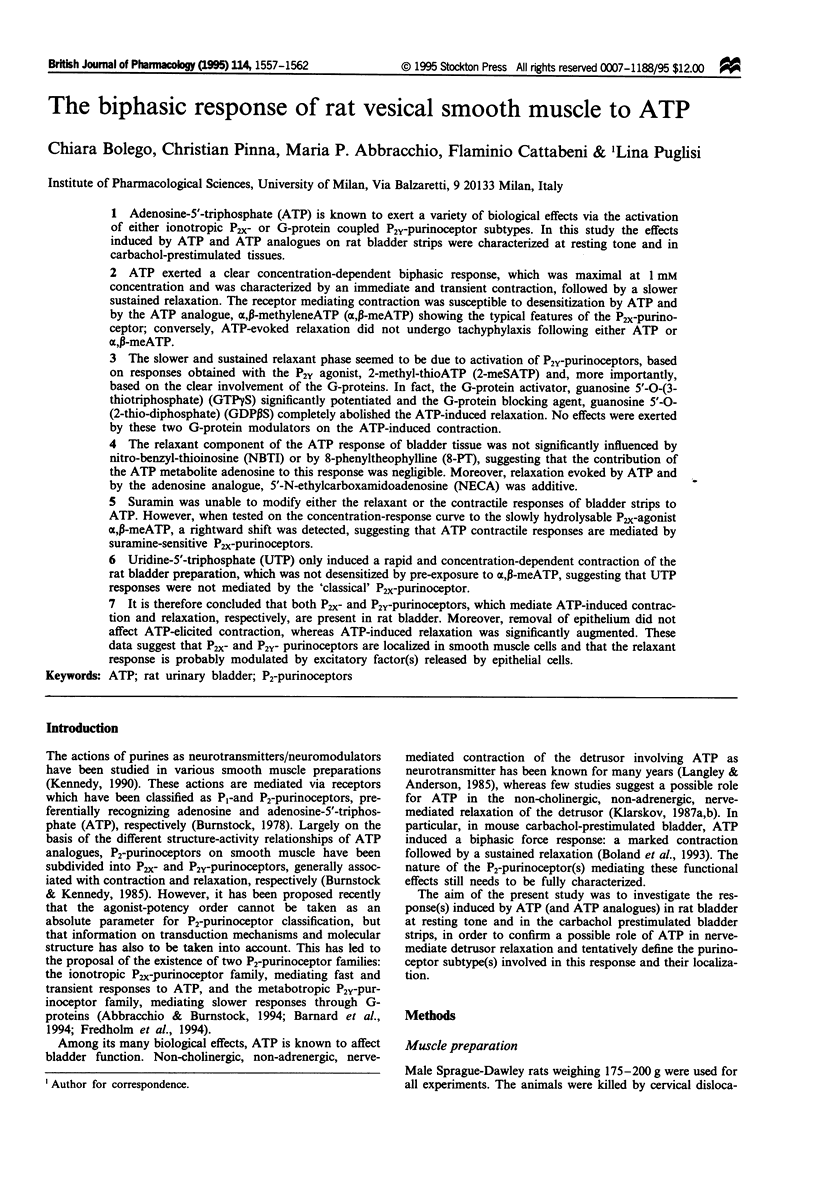
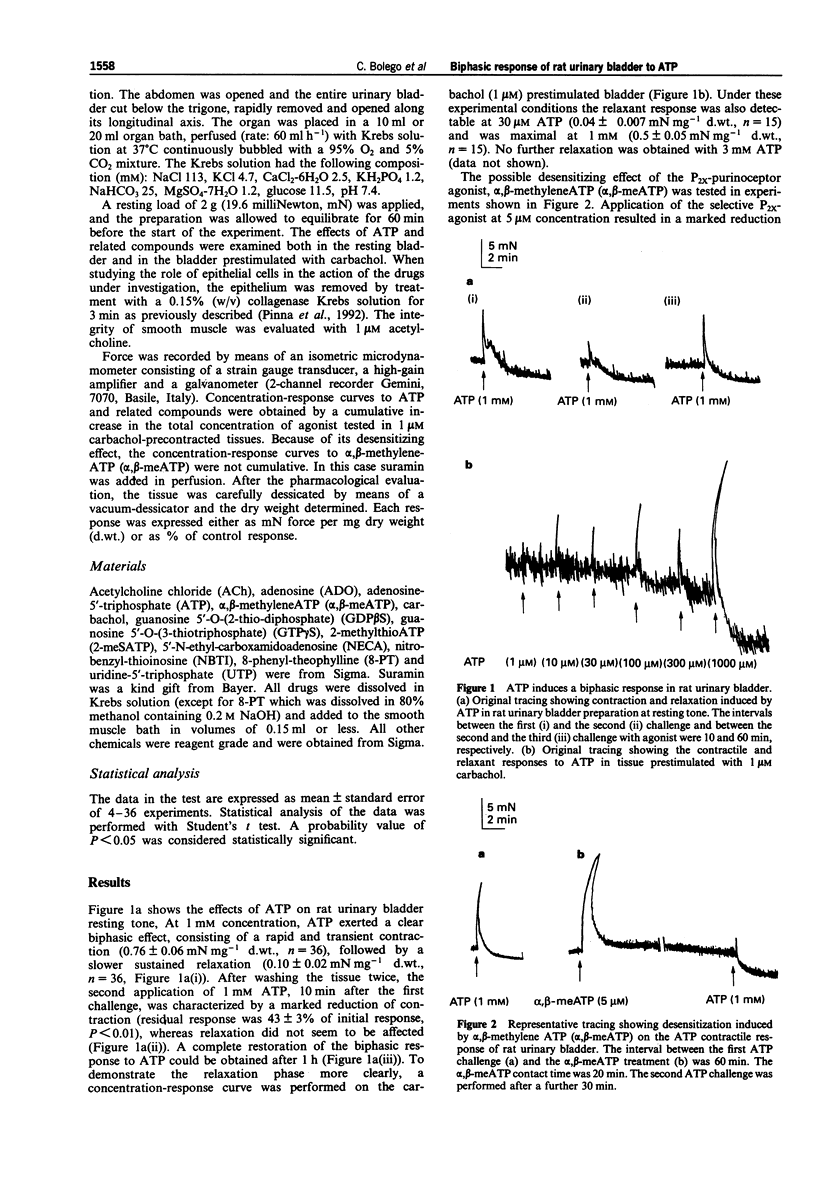
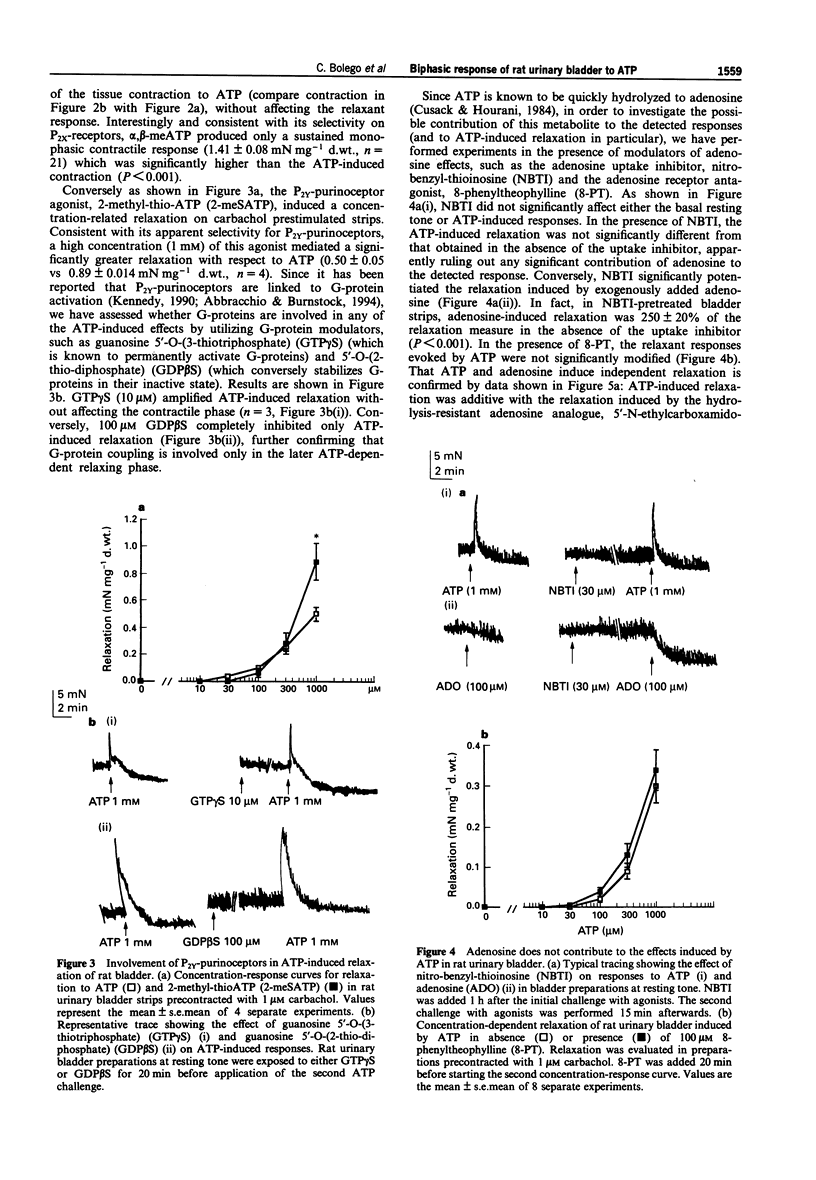
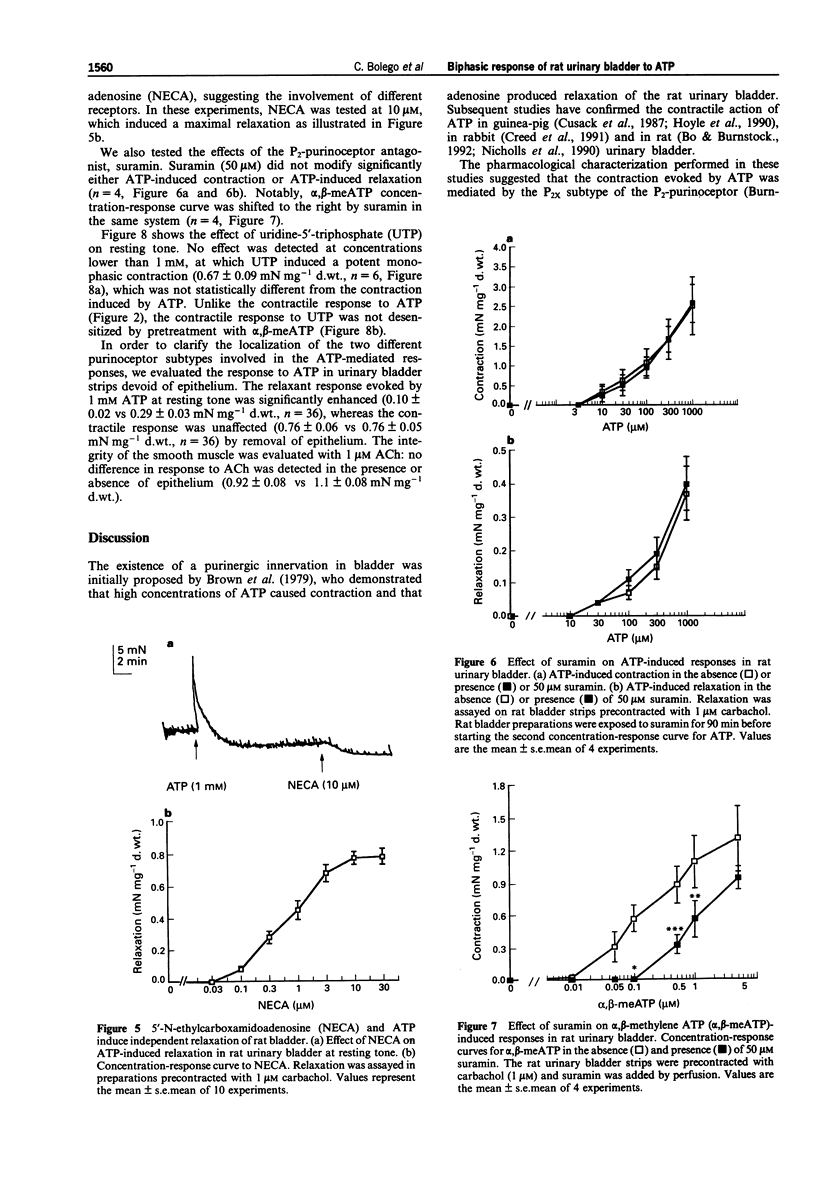
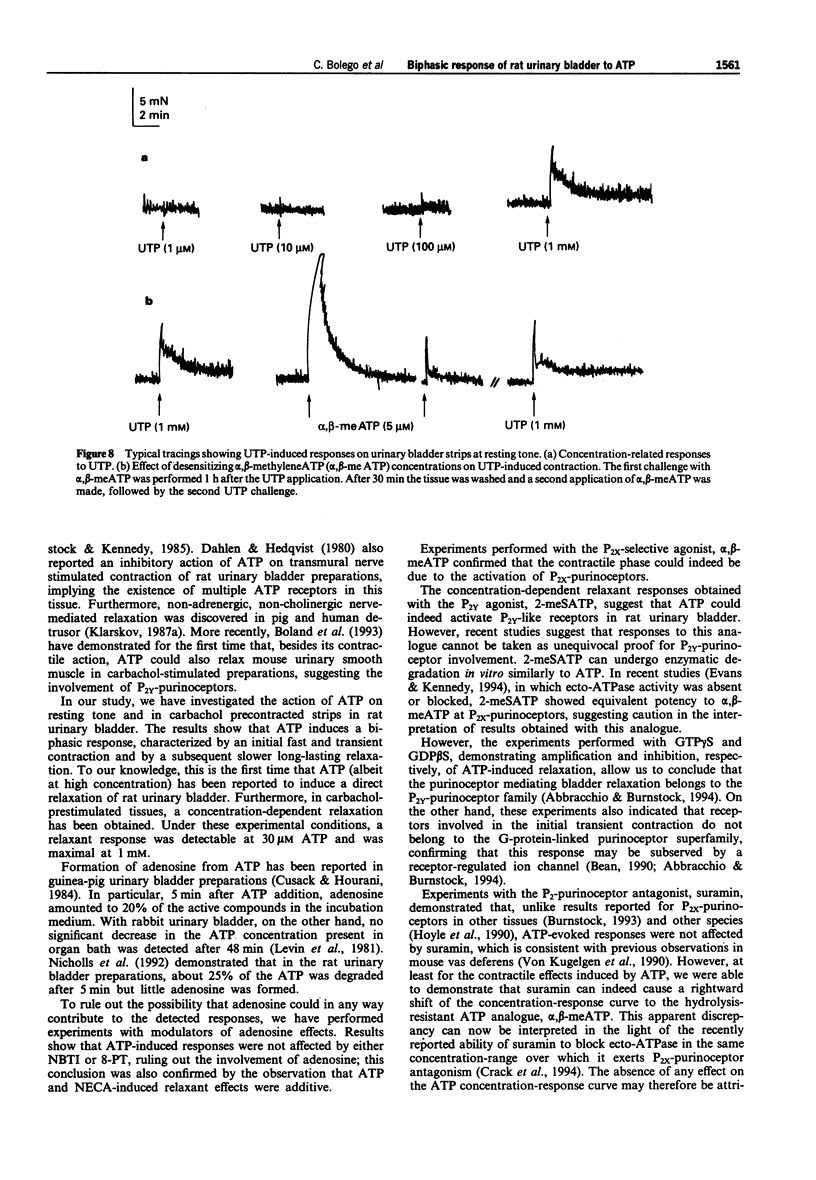
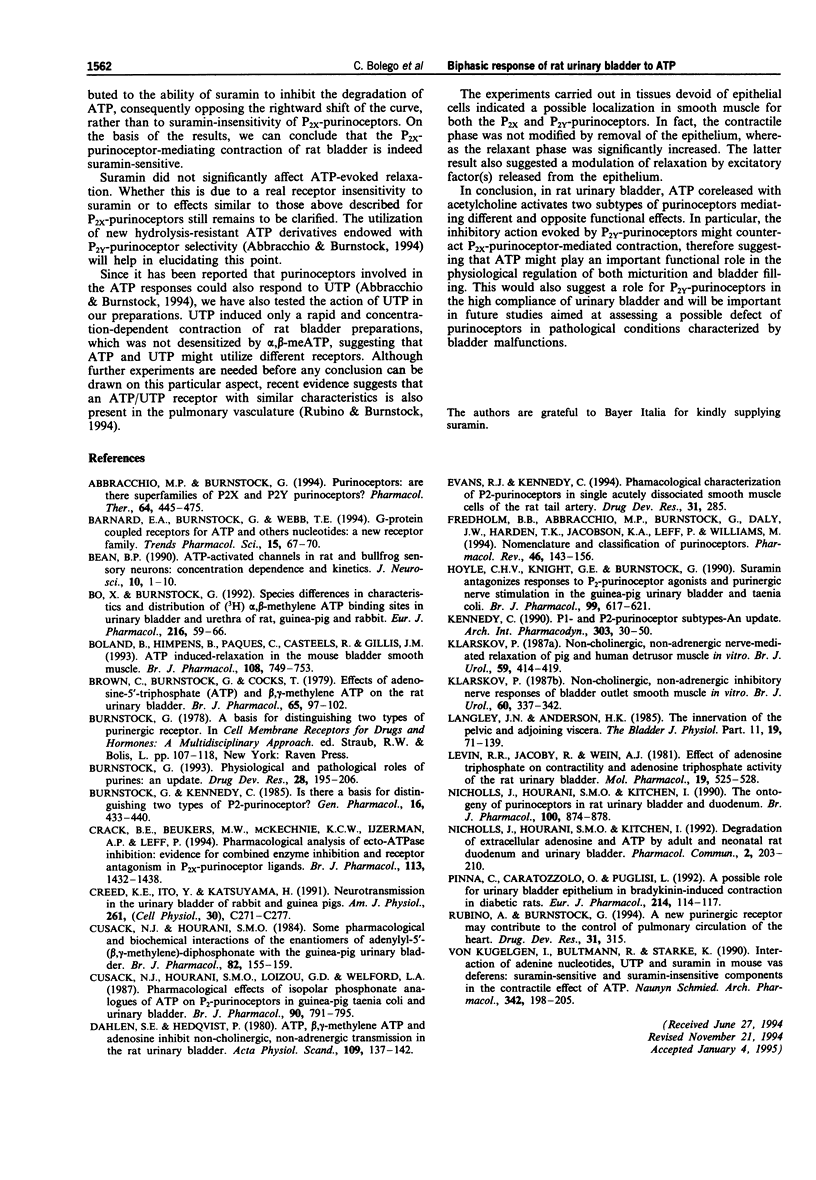
Selected References
These references are in PubMed. This may not be the complete list of references from this article.
- Abbracchio M. P., Burnstock G. Purinoceptors: are there families of P2X and P2Y purinoceptors? Pharmacol Ther. 1994;64(3):445–475. doi: 10.1016/0163-7258(94)00048-4. [DOI] [PubMed] [Google Scholar]
- Barnard E. A., Burnstock G., Webb T. E. G protein-coupled receptors for ATP and other nucleotides: a new receptor family. Trends Pharmacol Sci. 1994 Mar;15(3):67–70. doi: 10.1016/0165-6147(94)90280-1. [DOI] [PubMed] [Google Scholar]
- Bean B. P. ATP-activated channels in rat and bullfrog sensory neurons: concentration dependence and kinetics. J Neurosci. 1990 Jan;10(1):1–10. doi: 10.1523/JNEUROSCI.10-01-00001.1990. [DOI] [PMC free article] [PubMed] [Google Scholar]
- Bo X., Burnstock G. Species differences in characteristics and distribution of [3H] alpha,beta-methylene ATP binding sites in urinary bladder and urethra of rat, guinea-pig and rabbit. Eur J Pharmacol. 1992 May 27;216(1):59–66. doi: 10.1016/0014-2999(92)90209-m. [DOI] [PubMed] [Google Scholar]
- Boland B., Himpens B., Paques C., Casteels R., Gillis J. M. ATP induced-relaxation in the mouse bladder smooth muscle. Br J Pharmacol. 1993 Mar;108(3):749–753. doi: 10.1111/j.1476-5381.1993.tb12872.x. [DOI] [PMC free article] [PubMed] [Google Scholar]
- Brown C., Burnstock G., Cocks T. Effects of adenosine 5'-triphosphate (ATP) and beta-gamma-methylene ATP on the rat urinary bladder. Br J Pharmacol. 1979 Jan;65(1):97–102. doi: 10.1111/j.1476-5381.1979.tb17337.x. [DOI] [PMC free article] [PubMed] [Google Scholar]
- Burnstock G., Kennedy C. Is there a basis for distinguishing two types of P2-purinoceptor? Gen Pharmacol. 1985;16(5):433–440. doi: 10.1016/0306-3623(85)90001-1. [DOI] [PubMed] [Google Scholar]
- Crack B. E., Beukers M. W., McKechnie K. C., Ijzerman A. P., Leff P. Pharmacological analysis of ecto-ATPase inhibition: evidence for combined enzyme inhibition and receptor antagonism in P2X-purinoceptor ligands. Br J Pharmacol. 1994 Dec;113(4):1432–1438. doi: 10.1111/j.1476-5381.1994.tb17157.x. [DOI] [PMC free article] [PubMed] [Google Scholar]
- Creed K. E., Ito Y., Katsuyama H. Neurotransmission in the urinary bladder of rabbits and guinea pigs. Am J Physiol. 1991 Aug;261(2 Pt 1):C271–C277. doi: 10.1152/ajpcell.1991.261.2.C271. [DOI] [PubMed] [Google Scholar]
- Cusack N. J., Hourani S. M., Loizou G. D., Welford L. A. Pharmacological effects of isopolar phosphonate analogues of ATP on P2-purinoceptors in guinea-pig taenia coli and urinary bladder. Br J Pharmacol. 1987 Apr;90(4):791–795. doi: 10.1111/j.1476-5381.1987.tb11233.x. [DOI] [PMC free article] [PubMed] [Google Scholar]
- Cusack N. J., Hourani S. M. Some pharmacological and biochemical interactions of the enantiomers of adenylyl 5'-(beta, gamma-methylene)-diphosphonate with the guinea-pig urinary bladder. Br J Pharmacol. 1984 May;82(1):155–159. doi: 10.1111/j.1476-5381.1984.tb16453.x. [DOI] [PMC free article] [PubMed] [Google Scholar]
- Dahlén S. E., Hedqvist P. ATP, beta-gamma-methylene-ATP, and adenosine inhibit non-cholinergic non-adrenergic transmission in rat urinary bladder. Acta Physiol Scand. 1980 Jun;109(2):137–142. doi: 10.1111/j.1748-1716.1980.tb06578.x. [DOI] [PubMed] [Google Scholar]
- Fredholm B. B., Abbracchio M. P., Burnstock G., Daly J. W., Harden T. K., Jacobson K. A., Leff P., Williams M. Nomenclature and classification of purinoceptors. Pharmacol Rev. 1994 Jun;46(2):143–156. [PMC free article] [PubMed] [Google Scholar]
- Hoyle C. H., Knight G. E., Burnstock G. Suramin antagonizes responses to P2-purinoceptor agonists and purinergic nerve stimulation in the guinea-pig urinary bladder and taenia coli. Br J Pharmacol. 1990 Mar;99(3):617–621. doi: 10.1111/j.1476-5381.1990.tb12979.x. [DOI] [PMC free article] [PubMed] [Google Scholar]
- Kennedy C. P1- and P2-purinoceptor subtypes--an update. Arch Int Pharmacodyn Ther. 1990 Jan-Feb;303:30–50. [PubMed] [Google Scholar]
- Klarskov P. Non-cholinergic, non-adrenergic inhibitory nerve responses of bladder outlet smooth muscle in vitro. Br J Urol. 1987 Oct;60(4):337–342. doi: 10.1111/j.1464-410x.1987.tb04980.x. [DOI] [PubMed] [Google Scholar]
- Klarskov P. Non-cholinergic, non-adrenergic nerve-mediated relaxation of pig and human detrusor muscle in vitro. Br J Urol. 1987 May;59(5):414–419. doi: 10.1111/j.1464-410x.1987.tb04837.x. [DOI] [PubMed] [Google Scholar]
- Langley J. N., Anderson H. K. The Innervation of the Pelvic and adjoining Viscera: Part II. The Bladder. Part III. The External Generative Organs. Part IV. The Internal Generative Organs. Part V. Position of the Nerve Cells on the Course of the Efferent Nerve Fibres. J Physiol. 1895 Dec 30;19(1-2):71–139. doi: 10.1113/jphysiol.1895.sp000587. [DOI] [PMC free article] [PubMed] [Google Scholar]
- Levin R. M., Jacoby R., Wein A. J. Effect of adenosine triphosphate on contractility and adenosine triphosphatase activity of the rabbit urinary bladder. Mol Pharmacol. 1981 May;19(3):525–528. [PubMed] [Google Scholar]
- Nicholls J., Hourani S. M., Kitchen I. The ontogeny of purinoceptors in rat urinary bladder and duodenum. Br J Pharmacol. 1990 Aug;100(4):874–878. doi: 10.1111/j.1476-5381.1990.tb14107.x. [DOI] [PMC free article] [PubMed] [Google Scholar]
- von Kügelgen I., Bültmann R., Starke K. Interaction of adenine nucleotides, UTP and suramin in mouse vas deferens: suramin-sensitive and suramin-insensitive components in the contractile effect of ATP. Naunyn Schmiedebergs Arch Pharmacol. 1990 Aug;342(2):198–205. doi: 10.1007/BF00166965. [DOI] [PubMed] [Google Scholar]


